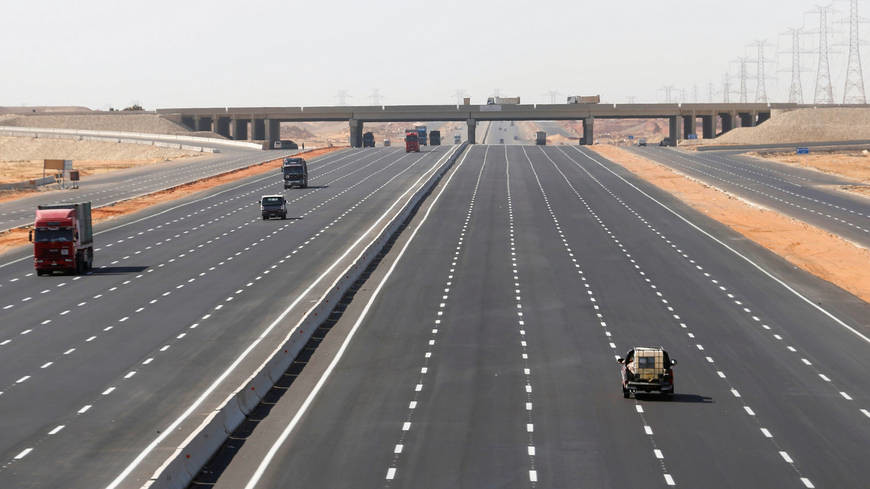The evolution of road networks in Africa highlights the technologies, infrastructures, and networks that have facilitated the circulation and exchange of people, goods, and ideas within local communities, regions, and systems of long-distance and intra-regional trade.
Major road networks are not merely stretches of asphalt; but vital arteries that boost trade, connect communities, and foster economic growth across the African continent. They represent a commitment to progress and the betterment of interconnectivity within Africa.
The Trans-African Highway Network is an ambitious, pan-African road network of major roads aiming to cover 56,683 kilometres by merging 9 highways. The mega project is a collaborative initiative by the African Union, the African Development Bank (AfDB), and the United Nations Economic Commission for Africa (UNECA) in collaboration with individual countries.
The following is a selected list of 10 of the largest road networks in Africa.
1. Cairo-Dakar Highway (Trans-African Highway 1/TAH 1)
About 8,636 kilometers long, the road network begins in Cairo along the Mediterranean coast of North Africa before tracing the Atlantic coast to Dakar, spanning 7 countries. It is a vital facilitator of West-North trade on the continent. According to Hitchwiki, most of the road is completely paved, except for the border region between Morocco and Mauritania, where it is only a track through the desert. The border between Morocco and Algeria is closed so the TAH 1 is not usable throughout.
2. Algiers-Lagos Highway (Trans-African Highway 2/TAH 2)
Also known as the African Unity Road, the 4500-kilometre road runs from Algiers in Algeria to Lagos in Nigeria via Niger; therefore, it spans across 3 countries. It is a part of the Trans-African Highway Network. Construction on the highway entered its final construction phase in February last year.
3. Tripoli-Windhoek-Cape Town Highway (Trans-Africa Highway 3/TAH 3)
This route is a key part of the Trans-African Highway network, stretching over 10,000 kilometres, and is designed to connect North and Southern Africa, starting from Tripoli in Libya to Cape Town. It spans across 9 countries, including Chad, Cameroon, the Central African Republic, the Congo, the DRC, Angola, and Namibia. According to Wikipedia, this route has the most missing links and requires the newest construction, as only national paved roads in Libya, Cameroon, Angola, Namibia, and South Africa can be used to any extent.

4. Cairo-Gaborone-Cape Town Highway (Trans-African Highway 4/TAH 4)
This road connects Cairo, Egypt to Cape Town, South Africa, traversing the length of the continent. It follows much of the original route of the Great North Road but has a few differences. For instance, TAH 4 passes through Addis Ababa, Ethiopia, while the original Great North Road went directly through South Sudan from Kenya. This road will cover an estimated 10,288 kilometres, starting in Egypt, then going to Sudan, Ethiopia, Kenya, Tanzania, Zambia, Zimbabwe, and Botswana, ending in Cape Town.
5. Dakar-N’Djamena Highway (Trans-African Highway 5/TAH 5)
Also known as the Trans-Sahelian Highway, the 4500-kilometre route starts in Dakar, Senegal, before extending to Mali, Burkina Faso, Niger, Nigeria, and Cameroon, ending in N’Djamena in Chad. This makes it a vital trade corridor in the Sahel region. According to the African Development Bank AfDB, the network is spread as follows in the region: Senegal (801 kilometres), Mali (904 kilometres), Burkina Faso (862 kilometres), Niger (837 kilometres), and Nigeria (972 kilometres). While most parts of the road are under construction and some need rehabilitation, a 2021 AfDB report shows close to 800 km, especially in Mali, are paved and complete.
6. N’Djamena-Djibouti Highway (Trans-African Highway 6/TAH 6)
With a length of 4,219 kilometres, it crosses Chad before entering Sudan, where it cuts across the Darfur region in western Sudan and the town of Al-Fashir, the scene of the Darfur conflict, to northern Ethiopia, ending in Djibouti. With sections of the road passing through a hazardous region, construction on sections of the road is currently halted. Therefore, while up to 85% of the road is paved, according to Construct Africa, most sections of the road need rehabilitation.

7. Mauritania-Lagos Highway (Trans-African Highway 7/TAH 7)
Also known as the Trans-West African Coastal Highway, aims to link 12 West African coastal nations, from Mauritania to Nigeria in the east, with feeder roads already existing to two landlocked countries, Mali and Burkina Faso. The African Union (AU) estimates this network to be more than 4010 kilometres long. According to Euronews.com, most sections of the road are almost complete.
8. Lagos-Mombasa Highway (Trans-Africa Highway/TAH 8)
Connects Lagos, Nigeria and the Kenyan coast of Mombasa, covering 6,259 kilometres. Its course includes Cameroon (Yaoundé), from Lagos, across Bangui in the Central African Republic, and Kampala in Uganda, before settling in Mombasa, Kenya. Sections between Kenya and Uganda, most sections in the Central African Republic (CAR), and those in Cameroon and Nigeria are complete, leaving major gaps in the Democratic Republic of Congo
9. Beira-Lobito Highway (Trans-African Highway 9/TAH 9)
TAH 9 has a length of 3,523 km and connects Mozambique to Angola. It also cuts through the southern part of the Democratic Republic of the Congo, Zambia, and Zimbabwe, facilitating trade in the southern part of the continent. TAH 9 traverses through 5 countries, with most of the sections being in Angola. Most sections of the road are complete, except for gaps in sections of the road in the DRC and Angola.
10. The Great North Road
Also known as the Cape to Cairo Road or the Pan-African Highway, starts from Cape Town in South Africa, passes through Zimbabwe, Zambia, Tanzania, Kenya, Uganda, and Sudan, and ends in Cairo, Egypt. The route has an estimated length of 10,228 kilometres. While the road track is in place, the travel digital magazine site, travel.stackexchange.com, reports patches limiting transportation, especially between Egypt and Northern Kenya.


